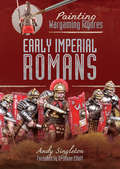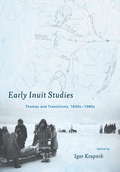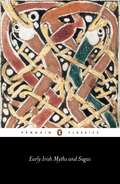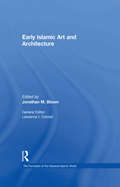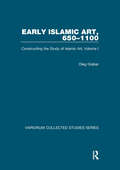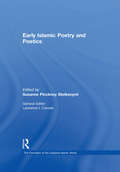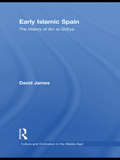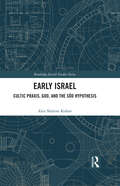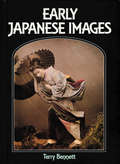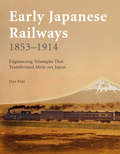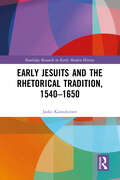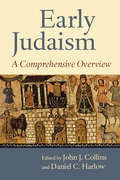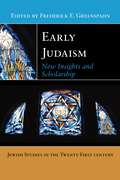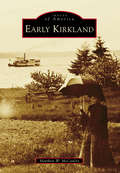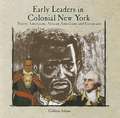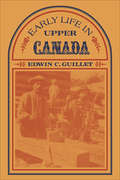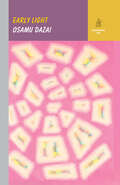- Table View
- List View
Early Imperial Romans: Early Imperial Romans (Painting Wargaming Figures)
by Andy SingletonA professional figure painter&’s guide to re-creating the legions of the Roman Empire. Andy Singleton has been modeling and painting most of his life and has been a professional commission figure painter for some years now. In this book, he shares his experience and tips of the trade with those collecting Early Imperial Romans. The emphasis is on achievable results and practical advice that is applicable to painting units or whole armies for wargaming purposes in a reasonable time frame, not on spectacular individual display pieces. Most of the figures featured in the numerous illustrations are either 28 or 25mm but the techniques described are easily adaptable to smaller sizes and both plastic and metal figures are covered. Clear, step-by-step guidance takes you through the process from the initial preparation and assembly of the figure, to finishing and basing. Themed chapters cover armor, weapons and equipment, clothing, skin tones, shields, and horses. All together it contains all the help you need to recreate your own legions of this most iconic army of ancient history.
Early Inuit Studies
by Igor KrupnikThis collection of 15 chronologically arranged papers is the first-ever definitive treatment of the intellectual history of Eskimology--known today as Inuit studies--the field of anthropology preoccupied with the origins, history, and culture of the Inuit people. The authors trace the growth and change in scholarship on the Inuit (Eskimo) people from the 1850s to the 1980s via profiles of scientists who made major contributions to the field and via intellectual transitions (themes) that furthered such developments. It presents an engaging story of advancement in social research, including anthropology, archaeology, human geography, and linguistics, in the polar regions. Essays written by American, Canadian, Danish, French, and Russian contributors provide for particular trajectories of research and academic tradition in the Arctic for over 130 years. Most of the essays originated as papers presented at the 18th Inuit Studies Conference hosted by the Smithsonian Institution in October 2012. Yet the book is an organized and integrated narrative; its binding theme is the diffusion of knowledge across disciplinary and national boundaries. A critical element to the story is the changing status of the Inuit people within each of the Arctic nations and the developments in national ideologies of governance, identity, and treatment of indigenous populations. This multifaceted work will resonate with a broad audience of social scientists, students of science history, humanities, and minority studies, and readers of all stripes interested in the Arctic and its peoples.
Early Irish Myths and Sagas
by Jeffrey GantzFirst written down in the eighth century AD, these early Irish stories depict a far older world - part myth, part legend and part history. Rich with magic and achingly beautiful, they speak of a land of heroic battles, intense love and warrior ideals, in which the otherworld is explored and men mingle freely with the gods. From the vivid adventures of the great Celtic hero Cu Chulaind, to the stunning 'Exile of the Sons of Uisliu' - a tale of treachery, honour and romance - these are masterpieces of passion and vitality, and form the foundation for the Irish literary tradition: a mythic legacy that was a powerful influence on the work of Yeats, Synge and Joyce.
Early Islamic Art and Architecture (The Formation of the Classical Islamic World #Vol. 23)
by Jonathan M. BloomThis volume deals with the formative period of Islamic art (to c. 950), and the different approaches to studying it. Individual essays deal with architecture, ceramics, coins, textiles, and manuscripts, as well as with such broad questions as the supposed prohibition of images, and the relationships between sacred and secular art. An introductory essay sets each work in context; it is complemented by a bibliography for further reading.
Early Islamic Art, 650–1100: Constructing the Study of Islamic Art, Volume I
by Oleg GrabarEarly Islamic Art, 650-1100 is the first in a set of four volumes of studies by Oleg Grabar. Between them they bring together more than eighty articles, studies and essays, work spanning half a century. Each volume takes a particular section of the topic, the three subsequent volumes being entitled: Islamic Visual Culture, 1100-1800; Islamic Art and Beyond; and Jerusalem. Reflecting the many incidents of a long academic life, they illustrate one scholar's attempt at making order and sense of 1400 years of artistic growth. They deal with architecture, painting, objects, iconography, theories of art, aesthetics and ornament, and they seek to integrate our knowledge of Islamic art with Islamic culture and history as well as with the global concerns of the History of Art. In addition to the articles selected, each volume contains an introduction which describes, often in highly personal ways, the context in which Grabar's scholarship developed and the people who directed and mentored his efforts. The present volume concentrates primarily on documents provided by archaeology understood in its widest sense, and including the study of texts with reference to monuments or to the contexts of these monuments. The articles included represent major contributions to the understanding of the formative centuries of Islamic art, focusing on the Umayyad (661-750) and Fatimid (969-1171) dynasties in Greater Syria and in Egypt, and on the Mediterranean or Iranian antecedents of early Islamic art. Historical, cultural, and religious themes, including the role of court ceremonies, the growth of cities, and the importance of the Qur'an, are introduced to help explain how a new art was formed in the central lands of the Near East and how its language can be retrieved from visual or written sources.
Early Islamic Poetry and Poetics (The Formation of the Classical Islamic World #37)
by Suzanne Pinckney StetkevychThis volume brings together a set of key studies on classical Arabic poetry (ca. 500-1000 C.E.), published over the last thirty-five years; the individual articles each deal with a different approach, period, genre, or theme. The major focus is on new interpretations of the form and function of the pre-eminent classical poetic genre, the polythematic qasida, or Arabic ode, particularly explorations of its ritual, ceremonial and performance dimensions. Other articles present the typology and genre characteristics of the short monothematic forms, especially the lyrical ghazal and the wine-poem. After thus setting out the full poetic genres and their structures, the volume turns in the remaining studies to the philological, rhetorical, stylistic and motival elements of classical Arabic poetry, in their etymological, symbolic, historical and comparatist dimensions. Suzanne Pinckney Stetkevych's Introduction places the articles within the context of the major critical and methodological trajectories of the field and in doing so demonstrates the increasing integration of Arabic literary studies into contemporary humanistic scholarship. The Selected Bibliography complements the Introduction and the Articles to offer the reader a full overview of the past generation of Western literary and critical scholarship on classical Arabic poetry.
Early Islamic Spain: The History of Ibn al-Qutiyah (Culture and Civilization in the Middle East)
by David JamesThis book is the first published English-language translation of the significant History of Islamic Spain by Ibn al-Qutiya (d. Cordova 367 / 977). Including extensive notes and comments, a genealogical table and relevant maps, the text is preceded by a study of the author and his work, and is the only serious examination of the unique manuscript since Pascual de Gayangos’ edition in 1868. Ibn al-Qutiya’s work is one of the significant and earliest histories of Muslim Spain and an important source for scholars. Although like most Muslims of al-Andalus in this period, Ibn al-Qutiya was of European origin, he was a loyal servant of the Iberian Umayyads, and taught Arabic, traditions (hadith) and history in the Great Mosque of Cordova. Written at the height of the Umayyad Caliphate of Muslim Spain and Portugal (al-Andalus), the History describes the first 250 years of Muslim rule in the peninsula. The text, first fully translated into Spanish in 1926, deals with all aspects of life, and includes accounts of Christians, Jews and Muslim converts. This book will be of great interest to scholars and students of the history of Spain and Portugal, Islamic history, and Mediaeval European history.
Early Israel: Cultic Praxis, God, and the Sôd Hypothesis (Routledge Jewish Studies Series)
by Alex Shalom KohavEarly Israel offers the most sweeping reinterpretation of the Pentateuch since the nineteenth-century Documentary Hypothesis. Engaging a dozen-plus modern academic disciplines—from anthropology, biblical studies, Egyptology and semiotics, to linguistics, cognitive poetics and consciousness studies; from religious studies, Jewish studies, psychoanalysis and literary criticism, to mysticism studies, cognitive psychology, phenomenology and philosophy of mind—it wrests from the Pentateuch an outline of the heretofore undiscovered ancient Israelite mystical-initiatory tradition of the First Temple priests. The book effectively launches a new research area: Pentateuchal esoteric mysticism, akin to a "center" or "organizing principle" discussed in biblical theology. The recovered priestly system is discordant vis-à-vis the much-later rabbinical project. This volume appeals to a diverse academic community, from Biblical and Jewish studies to literary studies, religious studies, anthropology, and consciousness studies.
Early Japanese Images
by Terry BennettThis fascinating book reproduces over 140 images taken between 1853 and 1905 by the most important local and foreign photographers then working in Japan. Almost one-fourth of the images are hand colored, superb examples of a rich art form long since vanished. The Japan of this book too has disappeared, but author and compiler Terry Bennett has put together a unique portrait of the country at perhaps its most decisive turning point, a nation about to abandon its traditional ways and enter the modern age.
Early Japanese Images
by Terry BennettThis fascinating book reproduces over 140 images taken between 1853 and 1905 by the most important local and foreign photographers then working in Japan. Almost one-fourth of the images are hand colored, superb examples of a rich art form long since vanished. The Japan of this book too has disappeared, but author and compiler Terry Bennett has put together a unique portrait of the country at perhaps its most decisive turning point, a nation about to abandon its traditional ways and enter the modern age.
Early Japanese Images
by Terry BennettThis fascinating book reproduces over 140 images taken between 1853 and 1905 by the most important local and foreign photographers then working in Japan. Almost one-fourth of the images are hand colored, superb examples of a rich art form long since vanished. The Japan of this book too has disappeared, but author and compiler Terry Bennett has put together a unique portrait of the country at perhaps its most decisive turning point, a nation about to abandon its traditional ways and enter the modern age.
Early Japanese Railways 1853 - 1914
by Dan FreeEarly Japanese Railways 1853-1914 is a cultural and engineering history of railway building in Japan during the Meiji era. The 19th century was the first age of sustained, comprehensive contact between Asia and the West. This book describes the history of Japanese social adaptation to railway development, with many details never-before-published in English. In addition, Early Japanese Railways 1853-1914 details the often overlooked American efforts to build the first railways in Japan. This richly illustrated account also takes a look at long disused corporate logos, locomotive data and headlamp marker codes. Many of the photos and illustrations, all pulled from the author's private collection, are quite rare and are not widely known, even in Japan.Appealing to more than just railroad fans, this fascinating account of early Japanese efforts to build railways also paints a clear picture of the Meiji era and the historical, cultural and social ramifications of the railway in Japan.
Early Japanese Railways 1853 - 1914
by Dan FreeEarly Japanese Railways 1853-1914 is a cultural and engineering history of railway building in Japan during the Meiji era. The 19th century was the first age of sustained, comprehensive contact between Asia and the West. This book describes the history of Japanese social adaptation to railway development, with many details never-before-published in English. In addition, Early Japanese Railways 1853-1914 details the often overlooked American efforts to build the first railways in Japan. This richly illustrated account also takes a look at long disused corporate logos, locomotive data and headlamp marker codes. Many of the photos and illustrations, all pulled from the author's private collection, are quite rare and are not widely known, even in Japan.Appealing to more than just railroad fans, this fascinating account of early Japanese efforts to build railways also paints a clear picture of the Meiji era and the historical, cultural and social ramifications of the railway in Japan.
Early Japanese Railways 1853 - 1914
by Dan FreeEarly Japanese Railways 1853-1914 is a cultural and engineering history of railway building in Japan during the Meiji era. The 19th century was the first age of sustained, comprehensive contact between Asia and the West. This book describes the history of Japanese social adaptation to railway development, with many details never-before-published in English. In addition, Early Japanese Railways 1853-1914 details the often overlooked American efforts to build the first railways in Japan. This richly illustrated account also takes a look at long disused corporate logos, locomotive data and headlamp marker codes. Many of the photos and illustrations, all pulled from the author's private collection, are quite rare and are not widely known, even in Japan.Appealing to more than just railroad fans, this fascinating account of early Japanese efforts to build railways also paints a clear picture of the Meiji era and the historical, cultural and social ramifications of the railway in Japan.
Early Jesuits and the Rhetorical Tradition (Routledge Research in Early Modern History)
by Jaska KainulainenThis book explores sixteenth- and seventeenth-century Jesuit contributions to the rhetorical tradition established by Isocrates, Aristotle, Cicero and Quintilian. It analyses the writings of those Jesuits who taught rhetoric at the College of Rome, including Pedro Juan Perpiña, (1530–66), Carlo Reggio (1539–1612), Francesco Benci (1542–94), Famiano Strada (1572–1649) and Tarquinio Galluzzi (1574–1649). Additionally, it discusses the rhetorical views of Jesuits who were not based in Rome, most notably Cypriano Soarez (1524–93), the author of the popular manual De arte rhetorica. Jesuit education, Ciceronianism and civic life feature as the key themes of the book.Early Jesuits and the Rhetorical Tradition, 1540–1650 argues that, in line with Cicero, early modern Jesuit teachers and humanists associated rhetoric with a civic function. Jesuit writings, not only on rhetoric, but also on moral, religious and political themes, testify to their thorough familiarity with Cicero’s civic philosophy. Following Cicero, Isocrates and Renaissance humanists, early modern Jesuit teachers of the studia humanitatis coupled eloquence with wisdom and, in so doing, invested the rhetorician with such qualities and duties which many quattrocento humanists ascribed to an active citizen or statesman. These qualities centred on the duty to promote the common good by actively participating in civic life.This book will appeal to scholars and students alike interested in the history of the Jesuits, history of ideas and early modern history in general.
Early Judaism: A Comprehensive Overview (Supplements To The Journal For The Study Of Judaism Ser. #121)
by John J. Collins Daniel C. HarlowCulled from The Eerdmans Dictionary of Early Judaism, a monumental, groundbreaking reference work published in late 2010, Early Judaism: A Comprehensive Overview contains fifteen first-rate essays from a diverse group of internationally renowned scholars. This volume provides the most comprehensive and authoritative overview available of Judaism in the Hellenistic and early Roman periods.Contributors:John M. G. BarclayMiriam Pucci Ben ZeevKatell BerthelotJohn J. CollinsErich S. GruenDaniel C. HarlowJames L. KugelAdam Kolman MarshakSteve MasonJames S. McLarenMaren R. NiehoffDavid T. RuniaLawrence H. SchiffmanChris SeemanGregory E. SterlingLoren T. StuckenbruckEibert TigchelaarEugene UlrichAnnewies van den HoekJames C. VanderKamJürgen K. Zangenberg
Early Judaism: New Insights and Scholarship (Jewish Studies in the Twenty-First Century #1)
by Frederick E. GreenspahnAn exploration of the emergence of Rabbinic Judaism drawing on primary sources and new methodsOver the past generation, several major findings and methodological innovations have led scholars to reevaluate the foundation of Judaism. The Dead Sea Scrolls were the most famous, but other materials have further altered our understanding of Judaism’s development after the Biblical era.This volume explores some of the latest clues into how early Judaism took shape, from the invention of rabbis to the parting of Judaism and Christianity, to whether ancient Jews considered themselves a nation. Rather than having simply evolved, “normative” Judaism is now understood to be the result of one approach having achieved prominence over many others, competing for acceptance in the wake of the destruction of the Jerusalem Temple in the year 70 CE. This new understanding has implications for how we think about Judaism today, as the collapse of rabbinic authority is leading to the return of the kind of diversity that prevailed during late antiquity. This volume puts familiar aspects of Judaism in a new light, exposing readers to the most current understanding of the origins of normative Judaism. This book is a must for anyone interested in the study of Judaism and its formation. It is the most current review of the scholarship surrounding this rich history and what is next for the field at large.
Early Kings of Norway
by Thomas CarlyleHarald took the sword, drew it, or was half drawing it, admiringly from the scabbard, when the English excellency broke into a scornful laugh, "Ha, ha; thou art now the feudatory of my English king; thou hast accepted the sword from him, and art now his man!" (acceptance of a sword in that manner being the symbol of investiture in those days.) Harald looked a trifle flurried, it is probable; but held in his wrath, and did no damage to the tricksy Englishman.
Early Kirkland (Images of America)
by Matthew W. MccauleyKirkland is a city of over 88,000 today, but when the US government opened the eastern shore of Lake Washington for homesteading in 1870, it was an unforgiving, mostly unpopulated primeval forest of giant old-growth conifers and tangles of undergrowth. Over the next two decades, hardscrabble pioneers gradually braved the wilds to stake and prove up 80- and 160-acre land claims. In 1887, a consortium of speculators, developers, and dreamers headed by a dynamic English steel industrialist sought to transform the scattered wilderness ranches into a steel manufacturing center, the �Pittsburgh of the West.� A boomtown was born, but within a few years, the steel scheme imploded, leaving in its ruins a few resilient families who undertook the arduous, decades-long struggle to forge a town. Early Kirkland provides a new look into Kirkland�s past, from its beginning to 1940.
Early Leaders In Colonial New York: Native Americans, African Americans, And Europeans (Primary Sources Of New York City And New York State)
by Colleen AdamsEarly Leaders in Colonial New York Native Americans, African Americans, and Europeans
Early Learning in Man and Animal (Psychology Library Editions: Comparative Psychology)
by W. SluckinOriginally published in 1970, this is a survey of findings on the learning of young animals and human infants. In an attempt to discover some of the characteristic features of early learning, it examines all types of learning from conditioning and the primitive process known as ‘imprinting’, usually associated with ducklings, to the beginnings of understanding and language. The so-called ‘critical’ periods for social learning and personality development are considered at some length, and a close look is taken at research methods used in studying early learning, and at the needs and problems of current research. As a textbook for students of psychology, biology and sociology this book would have been invaluable at the time of publication. It should still also be of interest to research workers in the fields of animal behaviour and developmental psychology, and to practising psychologists, psychiatrists and social workers, as it is an up-to-date summary of all the knowledge concerning early learning at the time.
Early Life in Upper Canada
by Edwin GuilletAlthough there were abundant hardships, early life in Upper Canada was romantic and colourful in many ways. However, despite important contributions to the social and economic history of Canada, few good, comprehensive accounts have been generally available. Early Life in Upper Canada, originally published in 1933, is by far the finest history yet compiled, and it is now being reprinted in order to make available to a new generation an important and engrossing description of this area of Canadian history. The author, a distinguished Canadian historian, has drawn on contemporary letters, diaries, newspapers, and periodicals, as well as consulting all the existing histories, and he has supplemented these researches with interviews with persons who had personal contacts with early life in the Province. Mr. Guillet has compiled a thorough, accurate and delightfully readable history, that brings vividly to life the early settlers and their experiences. This is in accordance with the author's profound desire to make the study of Canadian history a delight rather than a chore. He has not concealed the unpleasant aspects of pioneer life, nor does he attempt to glamorize its difficulties. There is a tendency at times to forget that the founders of Upper Canada include hundreds of thousands of men and women of many nationalities, and fur traders, lumbermen, and voyageurs, as well as settlers. Their contributions, too, are acknowledged and recorded here. This book is profusely illustrated, with drawings made, in many cases, by army cartographers, who were skilled creative artists as well. Their paintings, fortunately, have been better preserved than were written accounts of the times, and are accurate depictions of pioneer life. The extensive bibliography and carefully prepared index will make this work invaluable for historians as well as for general readers.
Early Light (Storybook ND Series #0)
by Osamu DazaiEarly Light gathers three tales by Osamu Dazai, author of the wildly popular No Longer Human Early Light offers three very different aspects of Osamu Dazai's genius: the title story relates his misadventures as a drinker and a family man in the terrible fire bombings of Tokyo at the end of WWII. Having lost their own home, he and his wife flee with a new baby boy and their little girl to relatives in Kofu, only to be bombed out anew. "Everything's gone," the father explains to his daughter: "Mr. Rabbit, our shoes, the Ogigari house, the Chino house, they all burned up," "Yeah, they all burned up," she said, still smiling. "One Hundred Views of Mount Fuji," another autobiographical tale, is much more comic: Dazai finds himself unable to escape the famous views, the beauty once immortalized by Hokusai and now reduced to a cliche. In the end, young girls torment him by pressing him into taking their photo before the famous peak: "Goodbye," he hisses through his teeth, "Mount Fuji. Thanks for everything. Click." And the final story is "Villon's Wife," a small masterpiece, which relates the awakening to power of a drunkard's wife. She transforms herself into a woman not to be defeated by anything, not by her husband being a thief, a megalomaniacal writer, and a wastrel. Single-handedly, she saves the day by concluding that "There's nothing wrong with being a monster, is there? As long as we can stay alive."
Early Los Altos and Los Altos Hills
by Los Altos History Museum Don McdonaldLos Altos would never have existed if not for the Southern Pacific Railroad. Since the 1850s, Los Altos, Spanish for "heights" or "foothills," was the name generally applied to the two ranchos (San Antonio and La Purisima Concepcion) between Palo Alto and Mountain View southwest of El Camino Real. In 1906, visionaries Paul Shoup, who worked for the railroad, and Walter Clark, a Mountain View real estate developer, saw the potential to turn Sarah Winchester's ranch near Stanford University into an ideal San Francisco suburb. They would capitalize on new commuters--those who wanted to live in comfort in the country but work in the city. Slowly, a new town grew in influence well beyond its original Altos Land Company plat, realizing tremendous post-World War II expansion. Now two communities solidly embedded in Silicon Valley, Los Altos and Los Altos Hills share a school system, downtown shopping, libraries, and water system, as well as a history of interesting people.
Early Los Angeles County Attractions
by Cory Stargel Sarah StargelWith the arrival of affordable transcontinental rail travel in the late 1880s, hundreds of thousands of tourists and transplants began making the trip to Los Angeles. Quickly becoming a haven for Easterners escaping cold winters and crowded cities, Los Angeles and neighboring communities, such as Pasadena and Santa Monica, boasted a sunny Mediterranean climate and the unique situation of both nearby mountain resorts and seaside amusements. The city also developed a bustling shopping and entertainment district downtown. More than 200 vintage postcard images illustrate a greatly diverse range of popular early attractions, including Mount Lowe, Eastlake Park, Hollywood, the Wilshire district, Griffith Park, Cawston's Ostrich Farm, the downtown shopping and theater district, and the expansive beaches, ranging from the turn of the 19th century up until World War II.
